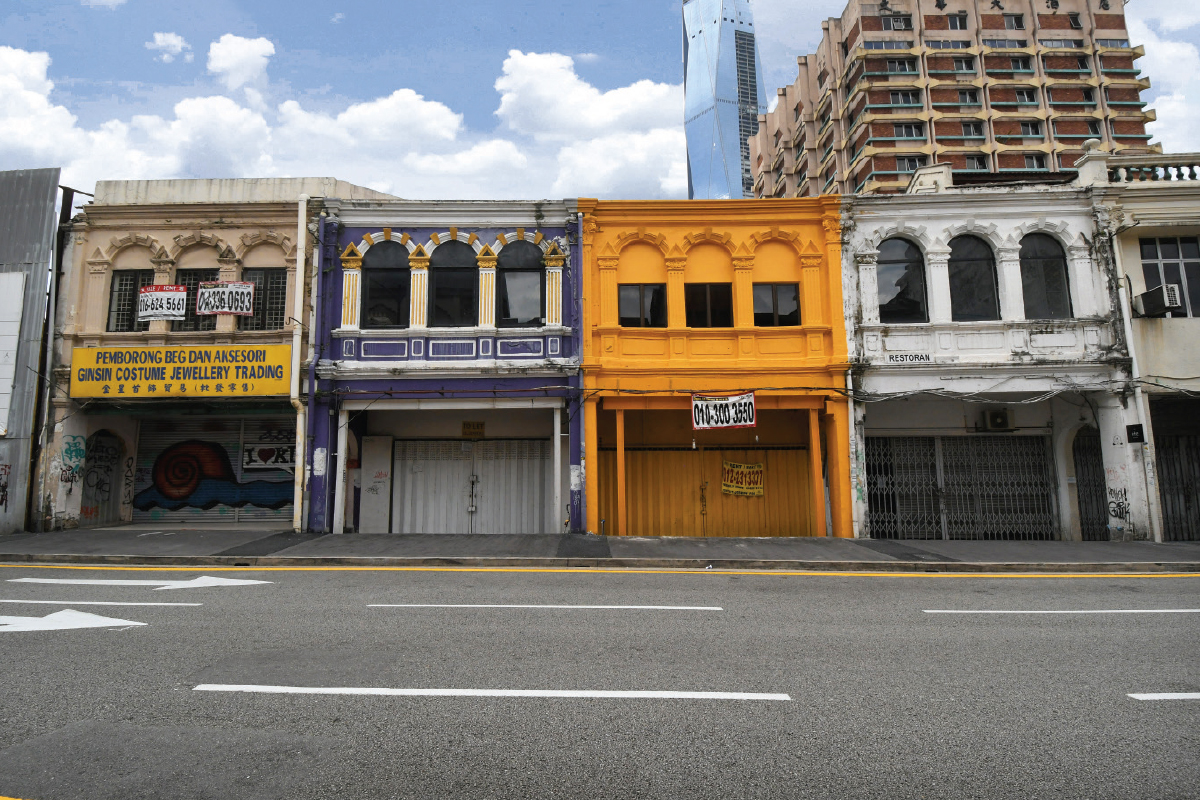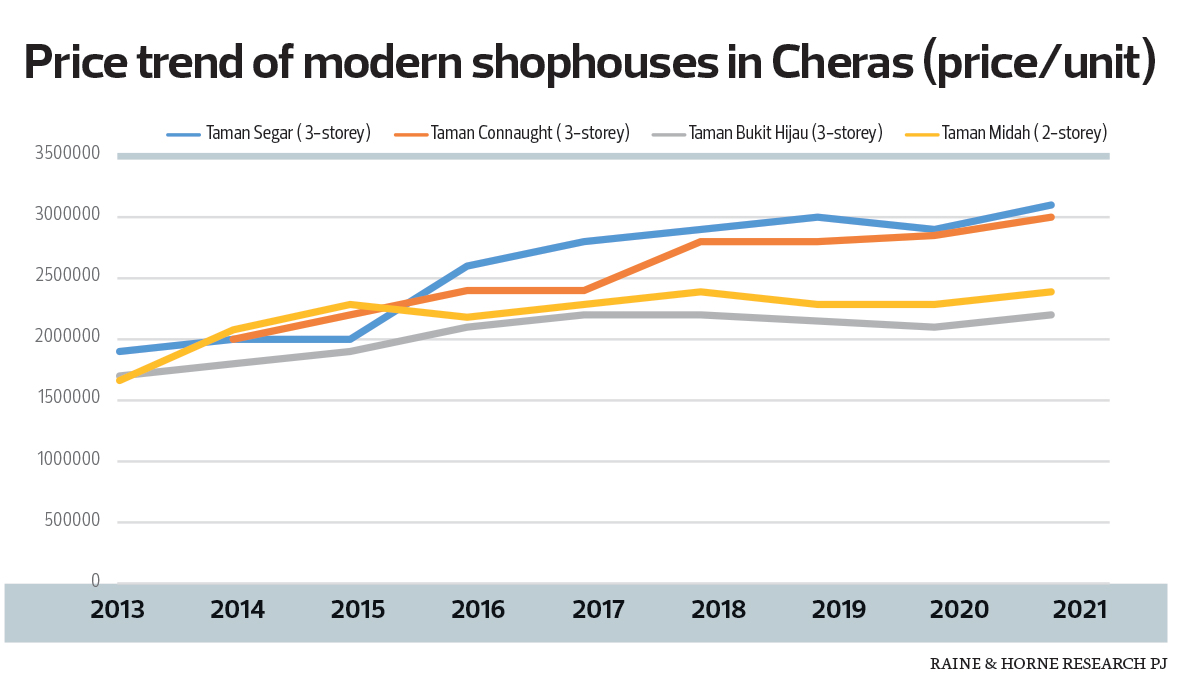
This article first appeared in City & Country, The Edge Malaysia Weekly on June 27, 2022 - July 3, 2022
The traditional 2-storey shophouse is ubiquitous for most Malaysians as it can be found in small towns and even in Kuala Lumpur. Over time, the humble structure has evolved and now serves more than its original purpose.
“Traditional shophouses in Malaysia were first built around the 18th or 19th century with the arrival of immigrants from China, and offer an architectural form that allows occupants to combine business activities and a place of residence,” says Henry Butcher Real Estate Sdn Bhd chief operating officer Tang Chee Meng.
Normally, the lower level serves as the “office” or place of business, with a kitchen at the rear that opens to a backstreet, while the upper level is the designated residential space for the owner’s family, he explains.
Raine & Horne International Zaki + Partners Sdn Bhd associate director James Tan concurs, pointing to an undergraduate honours thesis published in 2017 (by Ashley Wagner, titled, “Malaysian Shophouses: Creating Cities of Character”) to highlight how the shophouse has become a symbol of a culture and way of life in Malaysia that is slowly disappearing. Tan highlights these comments from the thesis:
“Chinese immigrants brought the building style of their homeland to the peninsula, but mixed with the environmental particulars, local culture and the European colonial presence, it morphed to create a truly unique vernacular. A vernacular that is quickly disappearing in the forest of towering high rises that have taken over the cityscape of Malaysia’s urban fabric. This represents a great loss of cultural identity and contributes to the perception of the decay of societal values in an increasingly fast-paced developing country. In a world where 70% of the world population is predicted to live in cities in a few short decades, having diverse, culturally relevant cities is a compelling concern.”
The decision to build other property types without considering shophouses is something that Rahim & Co International Sdn Bhd real estate agency CEO Siva Shanker believes developers should re-examine.
“People are not building the right things. They are chasing the money, which leads to a huge oversupply of serviced apartments, hotel rooms, office space and retail malls, but shophouses are good investments. This is because they don’t fly high during good times, but they don’t crash and burn during bad times, either,” he reasons.
Traditional shophouses are seldom built now, having been replaced with more modern versions. According to Raine & Horne International Zaki + Partners executive director Lim Lian Hong, “The traditional shophouse has an airwell. In those days, due to the requirements of the Public Health Act, an airwell was necessary to faciliate ventilation and because people lived there, you could not confine them in a confined space without an airwell as there wasn’t air-conditioning then.”
Lim remarks that the modern shophouse has a larger built-up now with the removal of the airwell requirement and that many traditional shophouses have been renovated to conceal the airwell.
Henry Butcher’s Tang points out, “The shophouses have evolved to become three to four storeys high, with some incorporating apartments on the upper floors while others turn the upper floors into offices. This later evolved into hybrid shopoffices which went up beyond five storeys and had lifts to facilitate vertical access.”
The transformation did not escape the notice of Rahim & Co’s Siva either, as the subsequent building of shophouses changed to shopoffices with a higher plot ratio and more floors, lifts, security and fees. Before long, he says, the area becomes a commercial centre.
Location trumps the competition
The property experts do not see any rivalry between traditional and modern shophouses.
Tang observes, “I don’t see it as a competition between traditional and modern shophouses. Good and not-so-good shophouses are differentiated by factors such as location, accessibility, visibility, size and profile of the market catchment, availability of parking bays and proximity to public transport hubs.”
He also highlights that some shops have become stratified to enable multiple ownership for different floors.
“In a later adaptation, the shops were integrated into the podium blocks of high-rise residences and gained access to common covered parking bays located in basements or surface car parks in the areas surrounding the building. [Also,] the depths and ceiling heights of the shops were reduced to cater to modern conveniences such as air-conditioning and firefighting requirements.”
Moreover, Tang points out that modern shophouses are now governed by building bylaws that resulted in designs that “are better suited to cater to modern business and living requirements”. However, compromises have been made, leading to lower ceiling heights and dispensing with the need for airwells and internal courtyards, hence making these modern shophouses “not as cooling and as well-ventilated as the older traditional ones”.
Lim also observes that shophouses mainly compete with their location. Those that have been in mature areas for longer tend to perform better compared to those in a newer location. He remarks that it takes time not only for shophouses in a new area to gain traction, but also for surrounding areas to grow to a sizeable population that can support the businesses that set up operations in the shophouses.
Siva agrees that a viable population plays a big role in the success of shophouses.
“If you build shophouses in local communities, they will thrive. It is because the local community will rent the ground floor and the local small offices will rent the upper floors.
“You will always have a market because in every economy in the world, SMEs (small and medium-sized enterprises) drive the economy.”
Siva adds that shophouses provide SMEs an opportunity to do business, but at a sustainable cost. “They may be at the bottom end, but play a big role because they are where the SMEs will operate from.”
He adds that building more shophouses and renting space to, for example, illegal roadside vendors — who currently do not pay tax and are using public space for free — will improve the value of shophouses and thus provide a stable investment property. As a result of good returns on the investment, owners will be encouraged to invest in other properties that will keep the wheels of the economy turning.
Advantages and disadvantages
As with most things, there are upsides and downsides to traditional and modern shophouses.
To Raine & Horne’s Tan, the advantages of a traditional shophouse include a larger floor area, unique appearance and design, good ventilation system in a heritage structure that is energy efficient, and location in prime areas.
However, he highlights that the downside could involve higher maintenance costs and difficulty of replacing materials used in the shophouses, especially materials that are not commonly found. Also, the building framework may be made of wood that could attract termites; and while the design may look good, it may be a turnoff for the younger generation, who want a more modern look. Also, it may have difficulty in maintaining its market value over time and most have very limited parking.
Meanwhile, the advantages of a modern shophouse could be said to include lower maintenance costs, simple design (easier for renovation), updated look that appeals to the younger generation and more parking bays.
Furthermore, Lim points out that modern shophouse areas provide better security, which in itself has pros and cons. Usually, areas with security have paid parking, which many do not like, as private parking can be expensive.
“People don’t want hassle; they want ease and convenience, and those kinds of requirements for shopping and attending to their services. They don’t like inconveniences,” says Lim.
“However, security is good for the occupants to protect against petty theft and robberies. If you are fully open [without security], thieves can just walk in like they would a 24-hour convenience store. If there is security, the robbers will think twice. It is a deterrent. Security may be good for the shop owner, but not so good for the customer.”
While the pandemic has made the going tough for the shophouse market, the property experts are optimistic about its performance in the longer term.
“Apart from end-users who are business owners, shophouses also appeal to investors who are attracted by the good returns in terms of rental yields and capital appreciation. The market outlook for both traditional and modern shophouses appears to be a bit impacted in the short term by the business slowdown caused by the Covid-19 pandemic, but should improve and will continue to be buoyant in the medium and longer term,” says Tang.
Lim concurs. “On the optimistic side, the pandemic situation is temporary. The population is still there and they still have their needs. You have the need for food and beverage, services such as accounting and hairdressing; basically, employment ... people need to work. All this means there is a place for shophouses to continue. But there might be a reduced need due to the impact of Covid-19 on businesses, as some had to close.”
To sum up, shophouses — modern or traditional — continue to play a significant role in the property market, which ultimately impacts the country’s economy.
Save by subscribing to us for your print and/or digital copy.
P/S: The Edge is also available on Apple's App Store and Android's Google Play.





